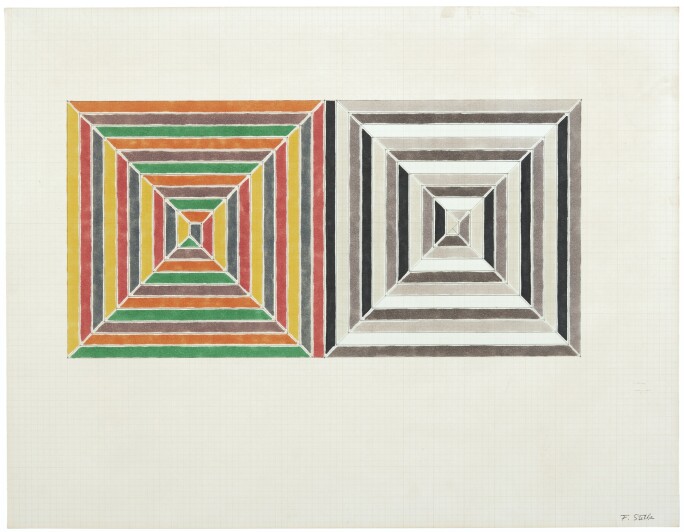About Minimalism

What is Minimalism?
Minimalism is a style of abstract art that rose to prominence in America in the 1960s and ‘70s. Taking inspiration from Constructivism, De Stijl, and the readymades of Marcel Duchamp, Minimalist artists rejected the heroic narratives of Abstract Expressionism in favour of pared down, purely self-referential geometric forms. While the action painters of the 1950s emphasized artistic subjectivity and emotional expression, this new generation of artists used prefabricated industrial materials and an economy of means to eradicate signs of authorship. Emptied of external references, the art object’s literal presence – it’s physical qualities, relationship to its surroundings, and the phenomenological experience of the viewer encountering the work – is foregrounded.
Characteristics and Style of Minimalism

Frank Stella famously proclaimed: “What you see is what you see.” Minimalism embraces this literalism, highlighting the physical properties of the art object – its scale, weight, placement and materiality – over symbolic or emotional meaning. Taking geometric abstraction to its logical extreme, Minimalist artwork uses precise, hard-edged forms, often squares and rectangles, to create nonhierarchical, mathematically regular compositions. Factory-made and shop-bought materials further downplay the artist’s hand and emphasize anonymity. The emphasis on form also invites a heightened awareness of the installation space or site, and a contextual interpretation of the artwork. While the movement is most closely associated with sculpture, Minimalists sought to dissolve traditional distinctions between art forms with unexpected materials and presentations. Indeed, Minimalist painting is decidedly un-painterly, without visible brushstrokes, and often features sculptural elements.
What is the legacy of Minimalism?

Minimalism presented a fundamental challenge to traditional understandings of how art was valued and experienced. By stripping away artistic subjectivity and expression, Minimalist works foreground the viewer’s encounter with the art object and its environment. In the late ‘60s and beyond, Postminimalist artists like Richard Serra, Eva Hesse and Bruce Nauman referenced the ideas of Minimalism while eschewing its extreme formalist rhetoric, paving the way for a diverse array of artistic styles from Earth Art to Feminist Art. In addition to the visual arts, the Minimalist influence extended to architecture, interior design, music, dance, fashion and cuisine; it remains an important tendency in many aspects of contemporary culture.
Timeline & History of Minimalism
 1959Frank Stella’s seminal Black Paintings are exhibited at the Museum of Modern Art in New York, signaling a rejection of gestural art.
1959Frank Stella’s seminal Black Paintings are exhibited at the Museum of Modern Art in New York, signaling a rejection of gestural art.
(left) Frank Stella, Arundel Castle (Small Version), 1959. 1965Donald Judd publishes “Specific Objects,” identifying the aesthetic priorities of Minimalist artists and rejecting traditional distinctions between art forms.
1965Donald Judd publishes “Specific Objects,” identifying the aesthetic priorities of Minimalist artists and rejecting traditional distinctions between art forms.
(left) Portrait of American artist Donald Judd (1928 - 1994) as he poses next to one of his works in the Leo Castelli gallery on East 77th street, New York, New York, February 6, 1966. (Credit Fred W. McDarrah / Contributor / Getty Images)
Donald Judd, Untitled, 1988. Estimate $500,000–700,000. 1965British philosopher Robert Wollheim indirectly coins the term “Minimalism” in an essay for Arts Magazine. Many artists, Donald Judd chief among them, dislike the moniker. While other names are proposed – including ABC Art, Reductive Art, Literalism, Primary Structures and Specific Objects – Minimalism eventually sticks.
(left) Donald Judd, Untitled, 1988. 1966Robert Morris writes “Notes on Sculptures,” calling for simple, intuitive forms and arguing for contextual interpretations of Minimalist sculpture.
1966Robert Morris writes “Notes on Sculptures,” calling for simple, intuitive forms and arguing for contextual interpretations of Minimalist sculpture.
(left) A scan of a Notes on Sculpture manuscript 1966The Jewish Museum in New York mounts the critically acclaimed Primary Structures exhibition, attracting wide attention and announcing the arrival of Minimalism as an art world force.
1966The Jewish Museum in New York mounts the critically acclaimed Primary Structures exhibition, attracting wide attention and announcing the arrival of Minimalism as an art world force.
(left) The exterior of Jewish Museum in New York 1967Sol LeWitt publishes “Paragraphs on Conceptual Art,” articulating principles important to both Minimalism and Conceptualism.
1967Sol LeWitt publishes “Paragraphs on Conceptual Art,” articulating principles important to both Minimalism and Conceptualism.
(left) Sol LeWitt 1971Critic Robert Pincus-Witten coins the term “Postminimalism” to refer to a diverse new wave of artists, from Richard Serra to Eva Hesse, who expand upon the conceptual and aesthetic concerns of Minimalism.
1971Critic Robert Pincus-Witten coins the term “Postminimalism” to refer to a diverse new wave of artists, from Richard Serra to Eva Hesse, who expand upon the conceptual and aesthetic concerns of Minimalism.
(left) Installation view of Eva Hesse's 2009 exhibition Studio Work, at the Fruitmarket Gallery in Edinburgh
Artists
Who are the Minimalists?
Perhaps the movement’s most famous exponent, Donald Judd is best known for his large-scale sculptures and installations, mostly in the form of boxes, presented in repetitive arrangements. Other prominent Minimalist sculptors include Robert Morris, Carl Andre and Sol LeWitt. The work of Dan Flavin, executed using commercially available fluorescent lighting tubes, represents an important Minimalist tendency toward light installation, which took off on the West Coast in the ‘60s and ‘70s with the Light and Space Movement.
There were also a number of important Minimalist painters. Frank Stella, whose Black Paintings (1958-1960) are often credited as the first pieces to exemplify the movement, championed formal concerns over the Romanticism of Abstract Expressionism. Other painters associated with Minimalism include Agnes Martin, Ellsworth Kelly, and Robert Ryman.
Minimalists
The Minimalists at Auction
The Minimalists at Auction
Have Something to Sell?
Have Something to Sell?
Get Started























